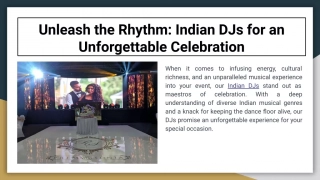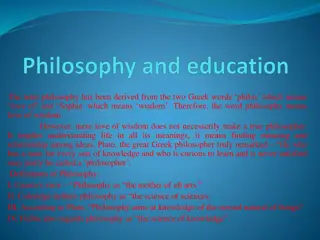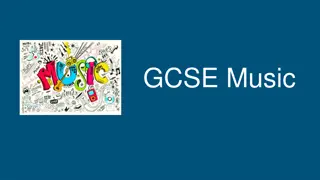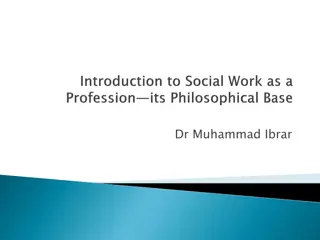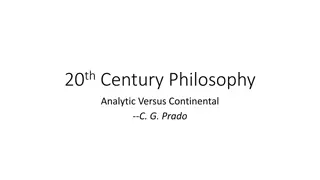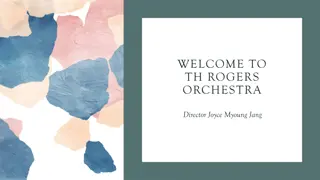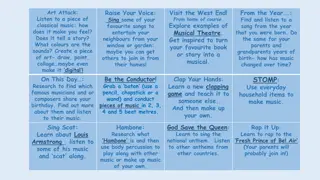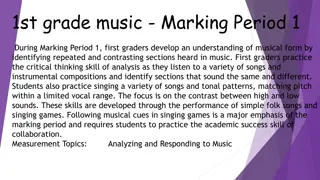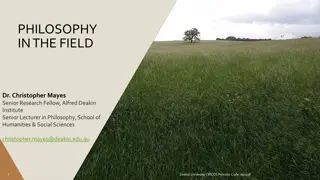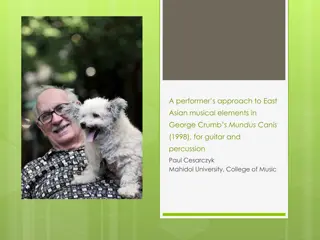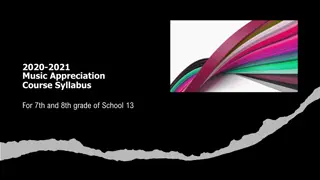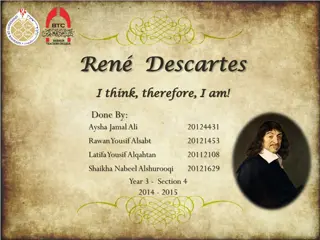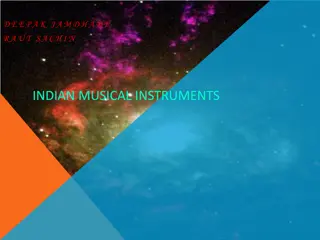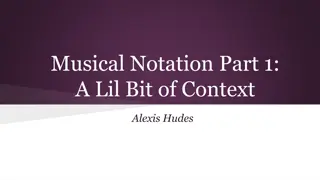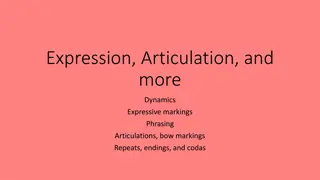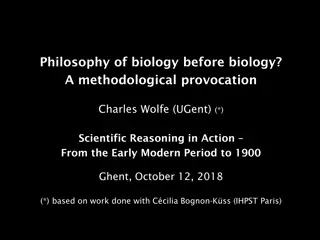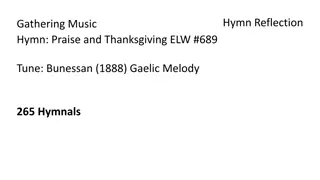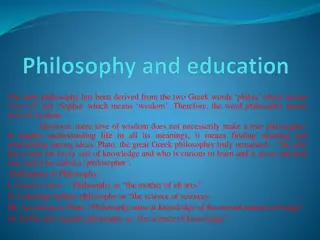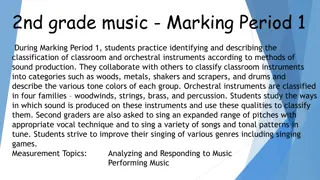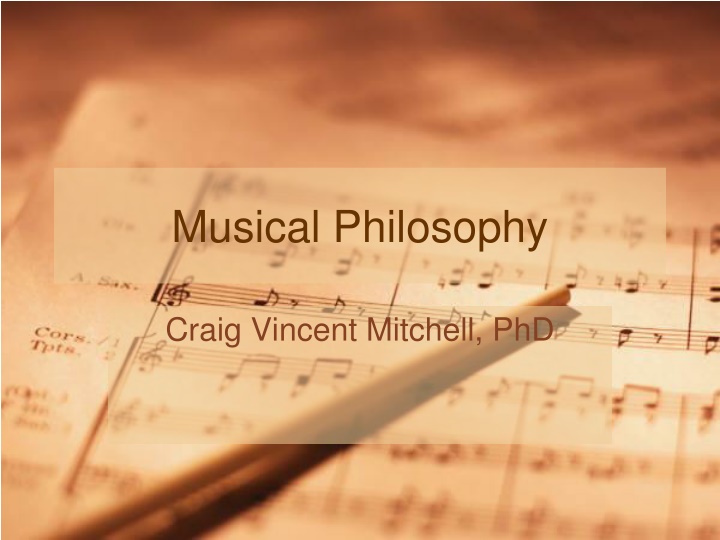
Musical Philosophy and the Music of the Spheres
Explore the fascinating connection between music and the cosmos through the lens of ancient philosophers like Pythagoras, Plato, Aristotle, Philo of Alexandria, and Plotinus. Discover the concept of "Musica Mundana," the harmony of the spheres, and how music reflects deeper truths about the universe and the human soul.
Download Presentation

Please find below an Image/Link to download the presentation.
The content on the website is provided AS IS for your information and personal use only. It may not be sold, licensed, or shared on other websites without obtaining consent from the author. If you encounter any issues during the download, it is possible that the publisher has removed the file from their server.
You are allowed to download the files provided on this website for personal or commercial use, subject to the condition that they are used lawfully. All files are the property of their respective owners.
The content on the website is provided AS IS for your information and personal use only. It may not be sold, licensed, or shared on other websites without obtaining consent from the author.
E N D
Presentation Transcript
Musical Philosophy Craig Vincent Mitchell, PhD
The Music of the Spheres Pythagoras of Samos (570-495 BC) believed that number seemed to govern musical tone He taught that each of the seven planets produced by its orbit a particular note according to its distance from the still center which was the Earth. This is what was called Musica Mundana, which is usually translated as Music of the Spheres.
Music of the Spheres The Music of the Spheres incorporates the metaphysical principle that mathematical relationships express qualities or "tones" of energy which manifest in numbers, visual angles, shapes and sounds all connected within a pattern of proportion. Pythagoras first identified that the pitch of a musical note is in proportion to the length of the string that produces it, and that intervals between harmonious sound frequencies form simple numerical ratios.
Music of the Spheres The Composition of the Soul The ideas of the Pythagoreans was taken up by Plato and his followers Music is a moral law. It gives soul to the universe, wings to the mind, flight to the imagination, a charm to sadness, gaiety and life to everything; It is the essence of order and lends to all that is good, just, and beautiful. Plato
Music of the Spheres Aristotle Politics and Poetics Aristotle rejected the concept of music of the spheres Music is a form of imitation and pieces of music are images of character. Music directly imitates the passions or states of the soul when one listens to music that imitates a certain passion, he becomes imbued with the same passion; and if over a long time he habitually listens to music that rouses ignoble passions, his whole character will be shaped to an ignoble form.
Music of the Spheres Philo of Alexandria Music of the Spheres The sound produced is so exquisite and rarified that our ordinary ears are unable to hear it. It is the Cosmic Music which, according to Philo of Alexandria, Moses had heard when he received the Tablets on Mount Sinai.
Music of the Spheres Enneads 5.9.11 Plotinus and the neo-platonists embraced the music of the spheres certainly all music, since the ideas which it has are concerned with rhythm and melody, would be of the same kind, just like the art which is concerned with intelligible number, and thus like the other arts would have its principles from the intelligible world Plotinus
Western Music The Church was the sole driver in the development of Western Music All non-western music is monophonic The Church is solely responsible for the development of polyphonic music Music is beautiful, because it was transcendent and focused on God
Eras in Western Music ERA Period Ancient Medieval Dates Recorded History- 399 500-1400 Premodernity Renaissance 1400-1600 Baroque 1600-1760 Classical 1730-1820 Modernity Romantic 1780-1910 High Modern 1890-1975 Postmodernity Contemporary 1975-present
Premodern: Ancient Music All through premodernity, there was no separation of the political, religious, legal, moral, and scientific Premodernity is based on metaphysical realism Community comes before the individual Music is expensive, so high art is sponsored by either the nobility or the church Music is monophonic
Premodern: Ancient Music Triple meter is developed, partially in response to the Arian Controversy Arius argued that Jesus Christ is not God The Nicean Creed affirmed the trinity in 325 AD Bishop Ambrose of Milan was a promoter of Church music
Premodern: Ancient Music The premodern worldview placed importance on the community over the individual Ephesian 5 and Colossians 3 emphasize singing as one The song Ubi Caritas (Where true charity is, there is God) dates back to the 4thcentury AD Church music was mainly vocal
Medieval Musical Philosophy Augustine Music of the Spheres The sound produced is so exquisite and rarified that our ordinary ears are unable to hear it. St Augustine believed men hear on the point of death, revealing to them the highest reality of the Cosmos.
Medieval Musical Philosophy De Musica Boethius (480-524 A.D.) The three branches of the Medieval concept of musica include: musica mundana (sometimes referred to as musica universalis) musica humana (the internal music of the human body) musica quae in quibusdam constituta est instrumentis (sounds made by singers and instrumentalists)
Medieval Music Philosophy The Roman statesman, philosopher and mathematician, Boethius explained that the soul and the body are subject to the same laws of proportion that govern music and the cosmos itself. We are happiest when we conform to these laws because "we love similarity, but hate and resent dissimilarity".
Premodern: Medieval Music Pope Gregory I (540-604 AD) Standardized church song and liturgy Liturgy is the customary public worship done by a specific religious group, according to its particular beliefs, customs and traditions. In ancient Greek, leitourgia, signifies the often expensive offers of service to the people, and thus to the polis and the state.
Premodern: Medieval Music Neumes were shorthand aids for the proper melodic recitation of a chant. The Eastern Roman Empire developed neumatic notation in the 9thcentury The Greek Orthodox Church maintained the use of neumes
Medieval: Church Modes Church modes: eight systems of pitch organization used in Gregorian chant. Likely originated from the medieval Byzantine okt chos. Documented as early as about 800. Eventually become the foundation of modern music scale and of tonality. The pitch organization can be seen in the arrangement of white and black keys of a piano.
Premodern: Medieval Music Hucbald of St. Amand writes Musica enchiriadis (895 AD), the first document to give rules for the performance of the organum. Organum- to sing in symphoniae. It is a plainchant melody with at least one added voice to enhance the harmony
Premodern: Medieval Music Guido D Arezzo (991- 1033) was a Benedictine monk He invented musical notation It is explained in his book Micrologus (1025 AD)
Medieval: Homophonic Music homophony is a texture in which two or more parts move together in harmony, the relationship between them creating chords. This is distinct from polyphony in which parts move with rhythmic independence, and monophony, in which all parts move in parallel rhythm and pitch. While homophony can be heard in nearly all European musical traditions, the first notated examples appeared during the Medieval period in dance music
Medieval: Polyphonic Music The Church developed musical terminology. Chord- singing in accord. A harmonic set of two or more notes that is heard as if sounding simultaneously. The Church developed polyphony and classified the types of singers (1250 AD) Soprano- the highest vocal range of all voice types. Sung by females or boys Alto- Latin (altus) high Tenor- Latin word for hold. Highest of the male voice types. It holds the Cantus Firmus. Bass- the foundation or the lowest voice type
Medieval: Polyphonic Music A cantus firmus ("fixed song") is a pre-existing melody forming the basis of a polyphonic composition. The Soprano, Alto, and Bass are defined by their relation to the Cantus Firmus (Tenor). The four parts form a harmony. It is a divine message, being comprised of Scriptural (the Word of God) or non-Scriptural church text. Appears with early polyphony (around 900).
Medieval: Polyphonic Music Cathedral Polyphonic Music Both emphasized order Both emphasized an ornateness in art Both emphasized the transcendent Both emphasized beauty
Renaissance: Polyphonic Music Italian Composer and Organist Preferred sacred vocal and instrumental polychoral music He developed the concertato style The concertato style led to the development of the concerto style Gabrieli composed early concerti (In Eccesiis) in 1587 Giovanni Gabrieli (1554-1612)
Renaissance: Baroque Music Concertato The concertato was a product of the Venetian school led by Gabrieli It involves contrast between opposing groups of voices and groups of instruments Most of this music was written so that a choir or instrumental group will be heard on one side and then responded to by the musical group on the other side Concerto Concerto- playing together In the early 17thcentury, almost all music with voices and a Baroque era harmonic structure for the music It is a solo instrument or instruments accompanied by an orchestra. It contrasts the individual against the community
Modernity: Baroque Music Baroque music forms a major portion of the classical music canon Composers include: Johan Sebastian Bach, George Friedrich Handel, Antonio Vivaldi and Johann Pachelbel. The Baroque period saw the creation of tonality The Baroque period established opera, cantata, oratorio, concerto and sonata as musical genres. The music was primarily transcendent because it focused on God and His glory The music was also complex, beautiful and focused on the community
Modernity: Baroque Music Johan Sebastian Bach 1685- 1750 Most famous German composer and church music director at the end of the Baroque period He subscribed to the idea that music should be transcendent and beautiful Compositions should be in accord with the music of the spheres Agreed with Martin Luther that a musical piece should be a sermon reflecting the glory of God
Modernity: Baroque Music Tonality is a musical system in which pitches or chords are arranged so as to induce a hierarchy of perceived stabilities and attractions. Tonality became the predominant European tradition of music from the late 1500s until the early 20th century, and remains almost entirely the basis of popular music Tonality is the eventual result of the Christian Church s music theory and practice.
Modernity: Classical Music Modernity moves to metaphysical nominalism The concerto became more focused on the individual The music became more secular and removed from the transcendent Music was pretty, but not beautiful Music was about being agreeable and pleasure
Modernity: Classical Music 1756- 1791 Wolfgang Amadeus Mozart Mozart showed prodigious ability from his earliest childhood. Already competent on keyboard and violin, he composed from the age of five and performed before European royalty. He composed over 600 works, many acknowledged as pinnacles of symphonic, concertante, chamber, operatic, and choral music.
Free Market impact on Music The free market resulted in greater economic growth by 1800 People had more money and leisure Common people could afford to learn to read music The quality and cost of musical instruments increased, but more people could afford them Music compositions could be performed by common people
Modernity: Romantic Music Romanticism is the European artistic and literary movement that arose in the second half of the 18th century, and Romantic music in particular dominated the Romantic movement in Germany. In part, it was a revolt against social and political norms of the Age of Enlightenment and a reaction against the scientific rationalization of nature Romantic is used in opposition to the restraint and formality of Classical models. Romanticism was viewed as the art most suited to the expression of emotions and often took on a much more nationalistic purpose.
Modernity: Romantic Music Ludwig Van Beethoven 1770-1727 A key transitional figure between the Classical and Romantic eras, he remains one of the most famous and influential of all composers. His best-known compositions include 9 symphonies, 5 concertos for piano, 32 piano sonatas, and 16 string quartets. He also composed other chamber music, choral works, and songs.
Modernity: Romantic Music Wilhelm Richard Wagner 1813-1883 A German composer, theatre director, and conductor who is primarily known for his operas Wagner revolutionized opera through his concept of the Gesamtkunstwerk ("total work of art"), by which he sought to synthesise the poetic, visual, musical and dramatic arts His controversial writings on music, drama and politics have attracted extensive comment because of his antisemitic sentiments.
Modern Music: Impressionism Impressionism in music was a movement among various composers in Western classical music, mainly during the late 19th and early 20th centuries, whose music focuses on suggestion and atmosphere, "conveying the moods and emotions aroused by the subject rather than a detailed tone picture".[
Modern Music: Impressionism The most prominent in musical impressionism is the use of color , or in musical term, timbre, which can be achieved through orchestration, harmonic usage, texture, etc. Other elements of music impressionism involve also new chord combination, ambiguous tonality, extended harmonies, use of modes and exotic scales, parallel motions, and extra- musically
Modern Music: Impressionism Achille Claude Debussy Josef- Maurice Ravel
20thCentury: Expressionism Theodor Adorno sees the expressionist movement in music, as seeking to "eliminate all of traditional music's conventional elements, everything formulaically rigid". Adorno also describes it as concerned with dissonance predominating, so that the "harmonious, affirmative element of art is banished" (Adorno 2009, 275 76).
20thCentury: Expressionism Musical expressionism is closely associated with the music Arnold Schoenberg composed between 1908 and 1921, which is his period of "free atonal" composition, before he devised twelve- tone technique (Schoenberg 1975, 207 208).
20thCentury: Expressionism Anton Webern Alban Berg
Conclusion Western music is different because of the church The church developed all of the important ideas in Western music The Church is responsible for musical notation The church is responsible for polyphony The Church is responsible for tonality
Conclusion Metaphysical realism resulted in music concerned with the transcendent Metaphysical realism also resulted in music concerned with the community Metaphysical nominalism resulted in music focused on being agreeable and with pleasure Metaphysical nominalism resulted in a focus on the individual
Conclusion Economic stagnation kept music in the hands of the church and nobility Free market economics resulted in the democratization of music

